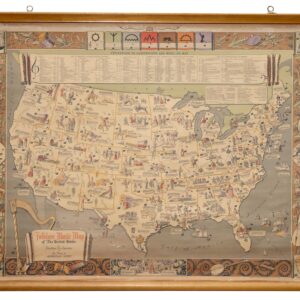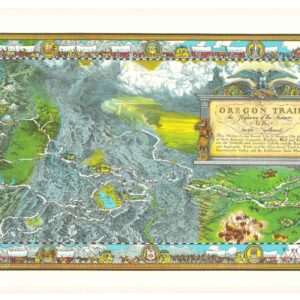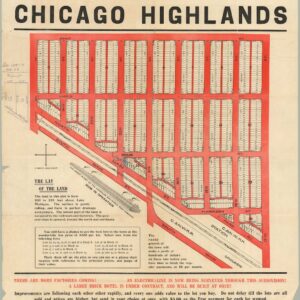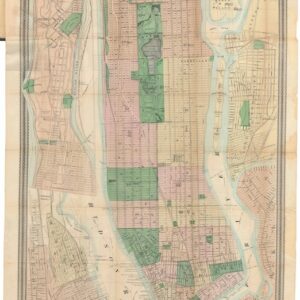A set of six hand-colored plates from Guilio Ferrario’s iconic encyclopedia showcasing the American Revolution.
[AMERICAN REVOLUTION] Boston, George Washington, Franklin, Philadelphia, Washington, D.C.
$600
1 in stock
Description
In 1816, the Milanese printer and librarian Giulio Ferrario began a process that would eventually lead to his 17-volume encyclopedia of the world’s cultures being published in full. To elevate his grand literary and intellectual ambition further, Ferrario illustrated his extensive text with engravings cut by the best engravers in Italy.
Neatline now offers six of these partly hand-colored plates, all with iconic motifs of the Revolutionary War and Founding Fathers. The individual prints are described in detail below, but they should be understood and experienced in unison, for it is in their combination that the Milanese intellectual captures part of the essence of the American Revolution.
The coverage of Ferrario’s work was comprehensive, and the encyclopedia was quickly considered one of the most comprehensive and decorative publications published in Italy until that point. Ferrario wrote the associated texts and employed some of the best engravers to produce the printing plates needed to reproduce his fine illustrations. Spirito Batelli, Giovanni Antonio Sasso, Paulo Fumagalli, and Gallo Gallina were among the famous engravers employed.
The American Plates
These six American motifs constitute a compelling perspective on the formative history of the new republic founded in America. They consist of:
Vol 1 / Tav 39: View of Boston: Engraved by Spirito Batelli, a panoramic view of Boston as seen from Cambridge across the Charles River. In the foreground, a prominent timber edifice proudly flies the American Flag, while the Boston cityscape can be seen across the river. The Boston Commons and State House stand out in the city’s skyline, while nine church steeples accentuate the clustered buildings of America’s bustling harbor. Ferrario’s print appears to be based on an engraving featured in the 1787 edition of Columbia Magazine.
Vol 2 / Tav 37+38: A double portrait of General Washington and Benjamin Franklin, two of the main instigators of the American Revolution and primary among our nation’s Founding Fathers.
Vol 2 / Tav 41: William Penn at the Foundation of Philadelphia: Engraved by Giovanni Antonio Sasso, this composition was based on the famous painting by Benjamin West (1738-1820), owned by the Pennsylvania Academy of Fine Arts. The motif depicts the arrival of William Penn, an English Quaker leader, who founded Pennsylvania in 1681 after receiving a land grant from King Charles II. Penn envisioned the colony as a haven for religious freedom, promoting tolerance and the fair treatment of Native Americans. Penn also established Philadelphia as the capital in 1682, implementing democratic principles and religious liberty through his Frame of Government. His vision attracted settlers from diverse backgrounds and influenced the ideals of freedom and democracy in the United States. To this day, Penn’s legacy as a champion of religious tolerance and democratic governance endures.
Vol 2 / Tav 42: View of the Pennsylvania State House in Philadelphia: Engraved by Bernardoni based on the original by Paulo Fumagalli; this view shows the Pennsylvania State House in Philadelphia, better known today as Independence Hall. Built in 1753, this was where The Second Continental Congress convened on May 10, 1775. This pivotal meeting saw the uniting of all Thirteen Colonies in support of the American Revolutionary War. It was, in effect, the event that established America’s independence from the British Empire.
Vol 2 / Tav 45: View of the Capitol in Washington D.C.: Engraved by Giovanni Antonio Sasso, this plate shows the Federal Capitol Building in Washington D.C. The Capitol was constructed in the late 18th century and largely completed by 1800. In 1814, substantial parts of the complex burnt to the ground in the so-called Burning of Washington. The Capitol got its name because then U.S. Secretary of State Thomas Jefferson insisted that the building that would shape American legislation be called “Capitol” rather than “Congress House.” The origin of the name dates back to Ancient Rome, where the Temple of Jupiter Optimus Maximus was located on Capitoline Hill (one of the seven hills in Rome).
Vol 2 / Tav 47: View of Washington’s estate at Mt Vernon: Engraved by Giovanni Antonio Sasso, Mount Vernon holds a pivotal place in American history as the estate of George Washington, the General of the Revolution and the first President of the United States. Situated along the Potomac River in Fairfax County, Virginia, Mount Vernon was first acquired by Washington’s great-grandfather in 1674. George Washington inherited the estate in 1754 and began expanding and renovating the property, creating the iconic mansion that still stands today. Its significance extends beyond being Washington’s home and residence: it has become a symbol of his leadership and the legacy of a just Revolution. Washington’s dedication to agricultural innovation added to the estate’s historical importance. Following Washington’s death in 1799, Mount Vernon was preserved as a memorial to America’s first great leader.
Context is Everything
Ferrario’s encyclopedic work was published in both Italian and French. The Italian language edition was first issued weekly between 1816 and 1827. Nevertheless, it was soon combined and published under the title: Il costume antico e moderno o storio del governo, della milizia, della religione. The Italian version contains an added Indice generale from 1829 (1 volume) and three volumes dedicated to “Aggiunte e rettificazioni all’ opera il costume antico e moderno”, published between 1831-1834. These four volumes were not part of the French language edition, meaning that the Italian edition totals 21 volumes. The complete French title was “Le Costume Ancien et Moderne ou Histoire du gouvernement, de la milice, de la religion, des arts, sciences et usages de tous les peuples anciens et modernes d’après les monuments de l’antiquité et accompagné de dessins analogues au sujet par le Docteur Jules Ferrario.”
Due to the many decorative prints inside, the work became so popular that themed 1820s octavo editions were produced in Florence and Naples. Neatline’s America plates come from one of these early octavo editions of Ferrario’s masterpiece.
Cartographer(s):
Gallo Gallina (1778 – 1837) was an Italian painter and engraver, active in a Neoclassic style. He was also active as a lithographer. He became the custodian of the Archeological Museum in the Brera Academy. He painted a canvas for the baptistery of the Duomo di Cremona.
Giulio FerrarioGiulio Ferrario (1767-1847) of Milan was an intellectual, publisher, printer, and librarian. He was the director of the Braidense National Library in Milan and the visionary behind the Società Tipografica de’ Classici Italiani. His monumental work Il costume antico e moderno constituted a history of the governments, militias, religions, and customs of all peoples in the ancient and modern world. It contained over 1,500 hand-colored plates depicting clothing through the ages and countless architectural depictions.
The compendium showcased some of the first views of iconic locations and events in the newly independent America.
Condition Description
Minor foxing, staining, and wear.
References
Colas 1050. Colas 1051 (Italian language). Colas 1049 (French language, variant to the plates & imprints). Hiler p.311. Lipperheide Ad.7 (Italian language with imprints).



